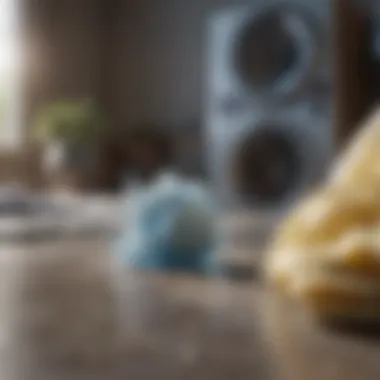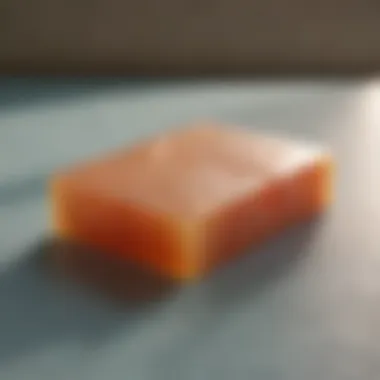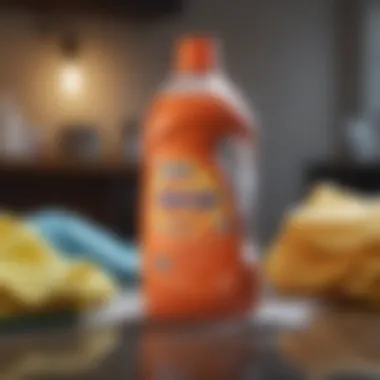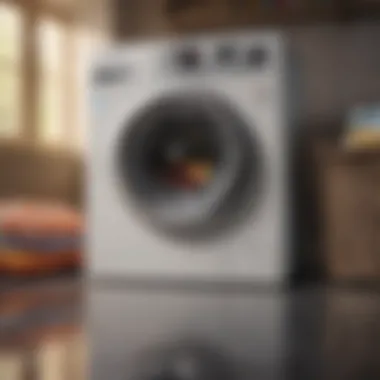DIY Laundry Detergent Sheets: A Sustainable Guide


Intro
In an age where sustainability is paramount, the household products we choose have a significant impact on our environment. For many, laundry detergents have long represented a source of chemical pollution, contributing to the vast amount of waste and harmful substances entering our waterways. As eco-conscious consumers, the time has come to take matters into our own hands by creating our own laundry detergent sheets. This guide will walk you through the essentials—ingredients, preparation methods, and the myriad benefits of this innovative solution.
Not only do these sheets reduce plastic waste, they offer a customizable approach to your laundry routine. You hold the power to select your ingredients, ensuring they meet your specific cleaning needs while also reflecting personal preferences. Moreover, this option often turns out more cost-effective in the long run, making it an appealing alternative to store-bought detergents, which can sometimes feel like they're just robbing your wallet.
In this exploration of DIY laundry detergent sheets, we aim to simplify the process while providing ample information to boost both your knowledge and confidence. Let's dive straight into the trends that are shaping this rising phenomenon.
Understanding Laundry Detergent Sheets
When it comes to laundry, attention shifts between the favorites, old habits, and new trends. Recently, the innovation of laundry detergent sheets is making waves. They offer a blend of simplicity and efficiency—promising not only cleaner clothes but also a more sustainable approach to cleaning.
Definition and Purpose
Laundry detergent sheets are thin, lightweight sheets infused with concentrated cleaning agents. These sheets dissolve in water to release their cleaning power, effectively washing clothes without the bulk of traditional detergent bottles. The purpose of these sheets is straightforward: they aim to simplify the laundry process while minimizing the environmental footprint. Consumers are constantly looking for convenience in their busy lives, and detergent sheets fit the bill. Their compact nature makes them ideal for those living in smaller spaces, or for anyone who wants to declutter their laundry room without compromising on cleanliness.
Advantages Over Traditional Detergents
Switching to laundry detergent sheets comes with a basketful of benefits. Firstly, storage is a game changer. Imagine clearing out that heavy, often cumbersome laundry detergent jug from under your sink. Sheets take up barely any space and can ease the organization in your laundry space.
Moreover, let's talk about dosage precision. With liquid or powder detergents, it’s all too easy to add too much, resulting in waste both in terms of money and the product itself. These sheets come pre-measured, making it simple to use the right amount for your load size every time, ensuring you get every last drop of soapy goodness and none of the excess mess.
On top of that, there’s a practical aspect—no spills or stains from accidentally knocking over a bottle. And who among us hasn’t faced that situation?
The Environmental Impact
The environmental implications of choosing laundry detergent sheets instead of traditional detergents cannot be overlooked. Firstly, the reduction in plastic waste is significant. Traditional detergent containers often end up in landfills, where they can take centuries to decompose. Laundry detergent sheets usually come in recyclable or even compostable packaging, which is a step in the right direction for eco-conscious consumers.
Furthermore, these sheets tend to be made with fewer harsh chemicals compared to their liquid counterparts, resulting in reduced water pollution and a lesser impact on aquatic life. Studies indicate that when we wash clothes, microplastics and chemicals can leach into water systems. Using detergent sheets, which often employ biodegradable components, can help mitigate these issues, making your laundry routine more environmentally friendly.
"Adopting laundry detergent sheets not only cleans your clothes but also helps clean up our planet!"
In summary, understanding laundry detergent sheets is crucial for those who wish to wash their clothes efficiently and sustainably. Whether it's about optimizing your laundry routine, reducing environmental impact, or embracing convenience, these sheets can offer a practical solution to modern laundry dilemmas.
Essential Ingredients for Laundry Detergent Sheets
Detergent Base Options
The heart of any laundry detergent is its cleansing agent. When you’re making sheets, consider what type of detergent base best meets your needs. You might encounter a variety of options, each with unique strengths:
- Sodium lauryl sulfate: This is a popular choice for its strong cleansing properties. It can easily remove tough stains but might be too harsh for delicate fabrics.
- Cocamidopropyl betaine: Derived from coconut oil, this is a gentler alternative, great for sensitive skin and biodegradable. Ideal for family usage.
- Plant-based surfactants: These are not only effective but also environmentally friendly. They come from renewable resources, making them a great choice for eco-conscious households.
In considering these options, reflect on your fabric care needs. A strong detergent may tackle grease but could be too aggressive for silk or wool. It's about balance.
Binders and Stabilizers
The role of binders and stabilizers cannot be overlooked. These ingredients help to hold everything together, giving your sheets their form and stability. Without them, your efforts could end up in a mushy mess. Two common choices are:
- Starch: This is a dependable natural binder. It aids in adhesion and structure, ensuring that your sheets don’t fall apart once dried.
- Cellulose gum: This is another strong option. It not only serves as a binder but also improves the texture of the sheets, making them easier to handle and dissolve in water.
Always opt for food-grade binders if you're concerned about skin safety. The right binder will enhance the user experience and make sure that every load of laundry is cleaned effectively.
Fragrance and Essential Oils
One of the most enjoyable parts of creating your own sheets is choosing how they smell. A pleasant fragrance can transform the laundry chore into a more enjoyable task. Here’s what you might consider:
- Essential oils: Classic choices like lavender or eucalyptus not only smell great but often bring additional antibacterial properties. They can aromatize your laundry naturally, leaving it fresh without synthetic fragrances.
- Fragrance oils: These are often more potent than essential oils and offer a broad range of scents. Just be wary of potential skin sensitivities that some fragrance oils may cause.


It’s worth pondering that while a lovely scent is important, it should not override safety. Always research any add-on before mixing it into your blend.
Colorants: To Use or Not to Use
The debate over colorants is a real pickle. On one hand, you might want your detergent sheets to have a visually appealing hue. On the other, many colorants can lead to skin irritation or environmental issues.
- Natural colorants: If you’re determined to add a bit of color, consider using beetroot powder for reds or spirulina for greens. These are derived from plants and are less likely to cause any negative reactions.
- Artificial colorants: While they can produce vivid shades, they often come with a laundry list of chemical concerns. Plus, they can stain fabrics if not properly controlled.
The key here? Weigh the visual appeal against safety and environmental impact. It’s possible to create appealing sheets without compromising the integrity of the wash.
Step-by-Step Preparation Process
Gathering Supplies
The first step before embarking on your laundry detergent sheet journey is gathering all necessary supplies. Here’s a short list:
- Detergent base: Choose one that's suitable for your needs. Options include sodium bicarbonate, sodium percarbonate, or any other laundry-specific base.
- Binders and stabilizers: Common choices are cornstarch or a plant-based binder to hold your sheets together.
- Fragrance oil or natural scents: Essential oils like lavender or eucalyptus can lend a delightful aroma to your sheets.
- Measuring tools: Accurate measurements are crucial, so having a scale or measuring cups handy will set you up for success.
Gathering these items ahead of time will streamline your making process and help you avoid interruptions. A little preparation goes a long way.
Measuring Ingredients
Once you have your supplies ready, measuring ingredients becomes the next significant step. Precision here can dramatically affect the performance of your sheets.
- Begin by referring to a reliable recipe that dictates the ratios of detergent base to binder.
- Adjust the quantities based on your desired yield—whether you're scaling up or batch-testing.
- Use a kitchen scale for dry ingredients, ensuring accurate measurement for an effective mix.
Remember, too much of one ingredient can lead to subpar results. If you want strong, effective sheets, it’s all about balance.
Mixing Techniques
Mixing is where the magic happens. This step dictates whether your sheets will hold together or crumble apart.
- Start with a mixing bowl that can accommodate all your ingredients.
- Gradually incorporate the binder with the detergent base. Some prefer to use a blender for a uniform mixture, while others might choose to do it by hand for a more tactile approach.
- Ensure that there are no lumps and that the texture resembles a coarse powder. If it feels too dry, a few drops of water may be added cautiously, but keep in mind that too much moisture can ruin the batch.
Achieving the right consistency is crucial, as it directly affects how well your sheets dissolve in water.
Forming the Sheets
Now, let’s get to the fun part—forming the sheets! Here, you'll transform your mixture into usable detergent.
- Lay out a silicone mold or parchment paper. The choice of surface matters for ease of removal.
- Scoop your mixture and press it firmly into shape, ensuring they are thick enough to hold together but not overly compacted.
- Use a spatula or your fingers to flatten the top, creating a nice, even surface for each sheet.
Leave enough space between sheets if using a mold, as they’ll expand slightly while drying.
Drying and Storing
Finally, drying is where your sheets take form and solidify. This step is key, as it determines their stability.
- Place your sheets in a dry, warm environment for at least 24 hours. A sunny spot works well, but make sure it’s not too humid, as moisture can lead to issues.
- Once dried, carefully remove the sheets from the molds.
- Store them in an airtight container, keeping away from moisture and heat.
By taking these steps seriously, you'll create your own customized detergent sheets that not only save you money but also protect the environment.
This complete process not only empowers you to make your laundry more efficient and eco-friendly, but also provides satisfaction derived from crafting something with your own hands.
Customization and Variations
Choosing Different Scents


Selecting a scent for your laundry detergent sheets is akin to choosing a perfume; it reflects not just preference but also sets the mood for your laundry experience. From fresh linen to nostalgic lavender, the scent can evoke feelings of cleanliness and comfort. It’s important to think about what you love to smell in your living space. Here are a few points to ponder:
- Personal Preference: Your favorite scents can transform a chore into a delightful experience. Think of citrus for an energizing effect or vanilla for a soothing atmosphere.
- Scent Strength: You might prefer a light touch of fragrance rather than an overpowering scent that lingers too long on clothes. Balancing the concentration is key.
- Essential Oils vs. Synthetic Fragrances: Natural essential oils, such as tea tree or eucalyptus, can provide fresh scents while offering antimicrobial properties, making laundry both aromatic and clean.
Adding Stain-Fighting Agents
Stains can be a laundry sidetrack, but adding stain-fighting agents can mean the difference between a perfect clean and a half-hearted wash. These items are particularly helpful in tackling common culprits like grass, wine, or grease. Here’s what to keep in mind:
- Choosing Your Agents: You can use ingredients like baking soda or white vinegar, well-known for their stain-lifting properties. Simply add these to your basic detergent preparation for a boost.
- Effectiveness: Consider how much of each agent to use. It's about finding the right balance—a pinch too little might not work, while a heap too much could risk fabric quality.
- Compatibility: Ensure that any added agent won’t interact negatively with your chosen base detergent.
Using Natural Additives
For eco-conscious laundry enthusiasts, adding natural ingredients can further align your sheets with your values. These additives serve practical functions while also offering further customization. Here are some considerations:
- Benefits of Natural Additives: Items like washing soda and citric acid not only aid in cleaning but are generally kinder on your skin and the environment, which is vital.
- Experimenting with Texture: Adding natural materials, like biodegradable glitter or dried lavender petals, may give your sheets a unique touch. Consider how they might affect the workflow of your laundry habits—sometimes less is more.
- Testing for Effectiveness: It’s a good idea to test each natural additive in a small batch first, just to ensure the mix results in the cleaning power you expect.
"Customization isn’t just about making what you want; it’s about enhancing what you already have with care and intention."
In summary, personalization through customization not only elevates your laundry routine but does so in a way that remains connected to your lifestyle and values. Each choice—from the scents you love to the natural ingredients you trust—reflects individual preferences that, when combined, create a truly unique laundry experience.
Practical Considerations
Sizing and Dosage Recommendations
Determining the right size for your laundry detergent sheets is crucial. Too large, and you risk wasting product; too small, and your laundry might not get as clean as you'd like. It's a balancing act that takes a bit of experimentation.
Generally, most household loads can be efficiently catered to with sheets measuring around 9 inches by 12 inches. This size allows for good coverage and dissolves well in standard washing machines. However, for particularly dirty loads or oversized items, consider using two sheets instead of one, adjusting your approach based on the filth level.
Dosage varies based on load size:
- For small loads, a single sheet should do the trick.
- Regular loads can usually get by with one or two sheets, depending on fabric type and how stained the clothes are.
- Heavier or dirtier loads? You might want to double up.
Compatibility with Different Fabrics
Understanding fabric compatibility is essential in ensuring that your homemade laundry detergent sheets do not inadvertently damage your clothing. Not all materials react well with the same cleaning agents. While most standard fabrics like cotton and polyester generally handle detergent sheets well, delicate fabrics like silk or wool require a bit more caution.
Here are some tips:
- Cotton/Polyester: These fabrics are robust and work well with regular doses of detergent.
- Microfiber: A little goes a long way here, so stick to one sheet if your load consists solely of microfiber.
- Delicate Fabrics: For items like silk or wool, it’s recommended to either use less quantity of detergent or consider switching to a gentler alternative—perhaps a sheet designed specifically for handwashing or delicates.
Storage and Shelf Life
Once your laundry detergent sheets are made, proper storage is the key to prolonging their shelf life. You want to keep them effective for as long as possible, avoiding environmental factors that could destabilize the ingredients. Store your sheets in a cool, dry area to prevent unnecessary moisture absorption, which can cause clumping or deterioration.
Here are a few guidelines for storing your sheets effectively:
- Use an airtight container to protect against humidity. A glass jar or a plastic container with a lid works well.
- Keep them out of direct sunlight to maintain their potency. Light can degrade certain compounds in your sheets.
- It’s also wise to mark the date of creation. Most homemade sheets can last up to six months if stored properly, but it’s always good to keep tabs on their condition.
"Homemade laundry detergent sheets not only provide a personalized touch to your laundry routine but also emphasize the importance of being mindful about what you use in your wash."
Troubleshooting Common Issues
When embarking on the journey of crafting your own laundry detergent sheets, it's crucial to understand that even the best plans can encounter bumps along the way. Troubleshooting common issues often saves time and can enhance the effectiveness of your sheets. Each component—be it the ingredients or the process—affects the overall outcome. Attention to these elements can offer beneficial insights that ensure a smoother laundry experience and greater satisfaction with your homemade products.
Sheets Not Dissolving Properly
A frustrating issue many encounter is the incomplete dissolution of their laundry detergent sheets, leading to the dreaded clumps or patches on clothing after washing. This can stem from several factors, primarily related to water temperature and the composition of the sheets. If the water is too cold, the sheets may not break down entirely, especially if your formula contains a significant proportion of binders.


To mitigate this, consider using your detergent sheets in warmer washes. Also, ensuring that the sheets are thin enough can promote faster dissolving. If you notice a recurring problem, you might need to adjust the binders or consider a different detergent base that dissolves more readily.
Here are some tips to prevent sheets from not dissolving:
- Experiment with thinner sheets: The thinner, the better for easy dissolution.
- Use warm water: Whenever possible, wash with warm or hot water to aid dissolution.
- Stir your water first: Giving the wash drum a little swirl before adding the sheets can also help them dissolve quickly.
"Preventing laundry issues before they happen is key to an efficient washing routine."
Unexpected Residue on Clothes
Finding residue lurking on your freshly washed clothes can feel like a sock in the gut. It can often be traced to an excessive amount of binder or stabilizer in your sheets. Over time, these ingredients can leave behind unwanted marks if they do not mix well with the laundry water. This issue can be especially pronounced with certain fabrics, which may retain residues more than others.
To address this, consider lessening the amount of binder you use in your recipe, ensuring that the sheets disintegrate properly during the wash cycle. Always test your product with multiple fabric types to see how they respond. Keeping fabric types in mind is essential; for instance, synthetics might need different care compared to cottons. Adjust your formulations based on your observations.
Overly Fragrant or Faintly Scented Laundry
Achieving the right fragrance balance can be tricky. Some people want their clothes smelling like a spring meadow, while others may prefer something more subtle. Finding yourself with clothing that has either overpowering scents or a subtle aroma might require tweaking your recipe. A reason for an overpoweringly fragrant outcome could be due to the concentration of essential oils used; using too much without considering the potency can lead to a perfume bomb.
If scents tend to fade after a wash, likely, you might be using oils that dissipate quickly or insufficiently mixing them into your detergent sheet concoction. For better results, try:
- Adding scent slowly: Start with a minimal amount of fragrance and increase gradually until you reach your desired aroma.
- Consider fragrance oils with better longevity: Some scents hold better than others; just be careful of allergens.
- Mix thoroughly: Make sure your fragrance is fully integrated into the mixture before forming the sheets.
Cost Analysis of Homemade versus Store-Bought
When it comes to laundry, many housewives and homeowners face the decision between homemade detergent sheets and those gleaming store-bought options. This section sheds light on the financial aspects involved, comparing both routes and helping you make an informed choice. By analyzing the costs, you can find ways to save not just money, but also make a choice that supports your values, be it sustainability or thriftiness.
Initial Investment on Ingredients
- Ingredient Variety: You might want to explore different brands that offer these ingredients, which can result in variation in cost. Sometimes, purchasing in bulk leads to better prices.
- Quality Matters: Higher quality items usually come at a premium, but they might perform better. It’s a tough balancing act between staying budget-friendly and ensuring effectiveness.
- One-Time Purchases: Items like molds, and food processor might seem pricey at first, but you will use them again and again, making their cost spread over multiple batches of detergent sheets.
Ultimately, while the initial cash output might raise an eyebrow, diving deeper into actual costs per wash reveals a more nuanced picture.
Long-Term Savings Potential
- Per Wash Cost: When you break the numbers down, homemade detergent can be strikingly inexpensive per load compared to off-the-shelf products. Once you master your recipe, the cost per sheet becomes considerably lower than popular brands.
- Absence of Marketing Costs: Store-bought detergents often come with hefty marketing labels. You’re basically paying for commercials and fancy packaging. With your homemade version, these expenses are non-existent, allowing you to direct that cash elsewhere.
- Less Consumption: Homemade options allow you to fine-tune your amounts, reducing waste and overuse. You might find yourself more mindful about how much detergent is really necessary—no more overloading the wash with excess detergent.
- Customization Savings: You can adjust ingredients for different laundry needs. Treating a particularly grimy load? Add a little extra cleaning agent—you control the costs and the results.
"Making your own is a small step for laundry, but a giant leap for your pocket and planet!"
Explore more about homemade cleaning products here.
Consider this: isn't it time to ditch those expensive brands and seize control of your laundry choices?
Closure
Summarizing the Benefits
Crafting your own detergent sheets offers a number of compelling advantages:
- Eco-Friendly Approach: By using natural ingredients, you avoid the harsh chemicals often found in commercial detergents. Not only do you protect your skin and lungs, but you also contribute to cleaner waterways, as many ingredients can break down more easily than synthetics.
- Cost Effectiveness: Initially, investing in raw materials may seem daunting but over time, the savings stack up. The cost per load is significantly lower when you opt for homemade sheets, benefiting your wallet in the long haul.
- Customization: Everyone's laundry needs are different. Whether you require a stain fighting formula or prefer a specific scent, making your own sheets allows for tailored creations to suit your family's requirements.
- Minimal Packaging Waste: Traditional detergents often come in non-biodegradable plastic containers. Homemade sheets can be easily stored in reusable containers or even biodegradable options, cutting down on unnecessary landfill contributions.
It's clear that the benefits significantly outweigh the drawbacks for many households.
Encouragement for DIY Approach
Venturing into the realm of DIY is both a liberating and empowering experience. It not only fosters self-sufficiency but also serves as a rewarding creative outlet. You might find the process of selecting your own ingredients deeply satisfying. It opens the door to experimenting with various combinations and discovering what works best in your wash. With each successful batch, confidence builds.
Moreover, the DIY approach carries a strong educational component. You gain insights into what goes into the products you use daily. This knowledge can shift your perspective on consumer habits and might even spark interest in other homemade alternatives around the house.
If it feels like a daunting process to start with, just know that everyone begins somewhere. Start small—maybe you create a single batch and test it out. You'll probably find that it not only performs well but might even become a fun activity to involve family members in.
Embrace the challenge, share your experiences with others, and inspire them too. In a world full of ready-made solutions, why not take the plunge and simplify your laundry routine in a meaningful and creative way?
"The journey of a thousand miles begins with one step." - Lao Tzu



